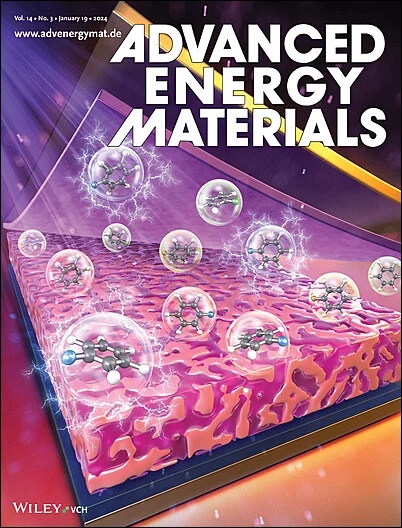高效、可扩展的焦耳加热合成用于完全水分解的自立型过渡金属磷化物电极
IF 26
1区 材料科学
Q1 CHEMISTRY, PHYSICAL
引用次数: 0
摘要
过渡金属磷化物(TMPs)有望作为低成本(预)电催化剂用于水裂解和其他与能源相关的应用。然而,由于高温反应,传统的合成方法在能量消耗、稳定性和重现性方面面临挑战。在这里,焦耳加热(JH)方法可扩展合成TMPs (Ni, Cu和In)作为独立电极和粉末。JH合成显示出可观的经济效率,显著降低了能源消耗和环境影响,同时由于加工时间短,提高了可重复性。用各种过渡金属掺杂剂合成了大规模的磷化镍基电极,并将其组装在阴离子交换膜水电解槽中作为阳极和阴极,在55°C下,在200 mA cm - 2下保持最大1.8 V的电池电位7天。这些结果强调了JH合成是一种有前途的方法,可扩展生产用于能量相关器件的高性能自立电极。本文章由计算机程序翻译,如有差异,请以英文原文为准。
Energy‐Efficient and Scalable Joule Heating Synthesis of Self‐Standing Transition Metal Phosphide Electrodes for Full Water Splitting
Transition metal phosphides (TMPs) show promise as low‐cost (pre)electrocatalysts for water splitting and other energy‐related applications. However, their traditional synthesis methods face challenges in energy consumption, stability, and reproducibility due to the reaction at high temperatures. Here, the Joule heating (JH) method for the scalable synthesis of TMPs (Ni, Cu, and In) as self‐standing electrodes and powders is presented. The JH synthesis demonstrates substantial economic efficiency and significantly reduces energy consumption and environmental impacts while enhancing reproducibility due to fast processing times. Large‐scale nickel phosphide‐based electrodes are synthesized with various transition metal dopants and assembled into an anion exchange membrane water electrolyzer as anode and cathode, maintaining a cell potential of a maximum of 1.8 V at 200 mA cm⁻2 under 55 °C for 7 days. These results highlight the JH synthesis as a promising approach for the scalable production of high‐performance self‐standing electrodes for energy‐related devices.
求助全文
通过发布文献求助,成功后即可免费获取论文全文。
去求助
来源期刊

Advanced Energy Materials
CHEMISTRY, PHYSICAL-ENERGY & FUELS
CiteScore
41.90
自引率
4.00%
发文量
889
审稿时长
1.4 months
期刊介绍:
Established in 2011, Advanced Energy Materials is an international, interdisciplinary, English-language journal that focuses on materials used in energy harvesting, conversion, and storage. It is regarded as a top-quality journal alongside Advanced Materials, Advanced Functional Materials, and Small.
With a 2022 Impact Factor of 27.8, Advanced Energy Materials is considered a prime source for the best energy-related research. The journal covers a wide range of topics in energy-related research, including organic and inorganic photovoltaics, batteries and supercapacitors, fuel cells, hydrogen generation and storage, thermoelectrics, water splitting and photocatalysis, solar fuels and thermosolar power, magnetocalorics, and piezoelectronics.
The readership of Advanced Energy Materials includes materials scientists, chemists, physicists, and engineers in both academia and industry. The journal is indexed in various databases and collections, such as Advanced Technologies & Aerospace Database, FIZ Karlsruhe, INSPEC (IET), Science Citation Index Expanded, Technology Collection, and Web of Science, among others.
 求助内容:
求助内容: 应助结果提醒方式:
应助结果提醒方式:


